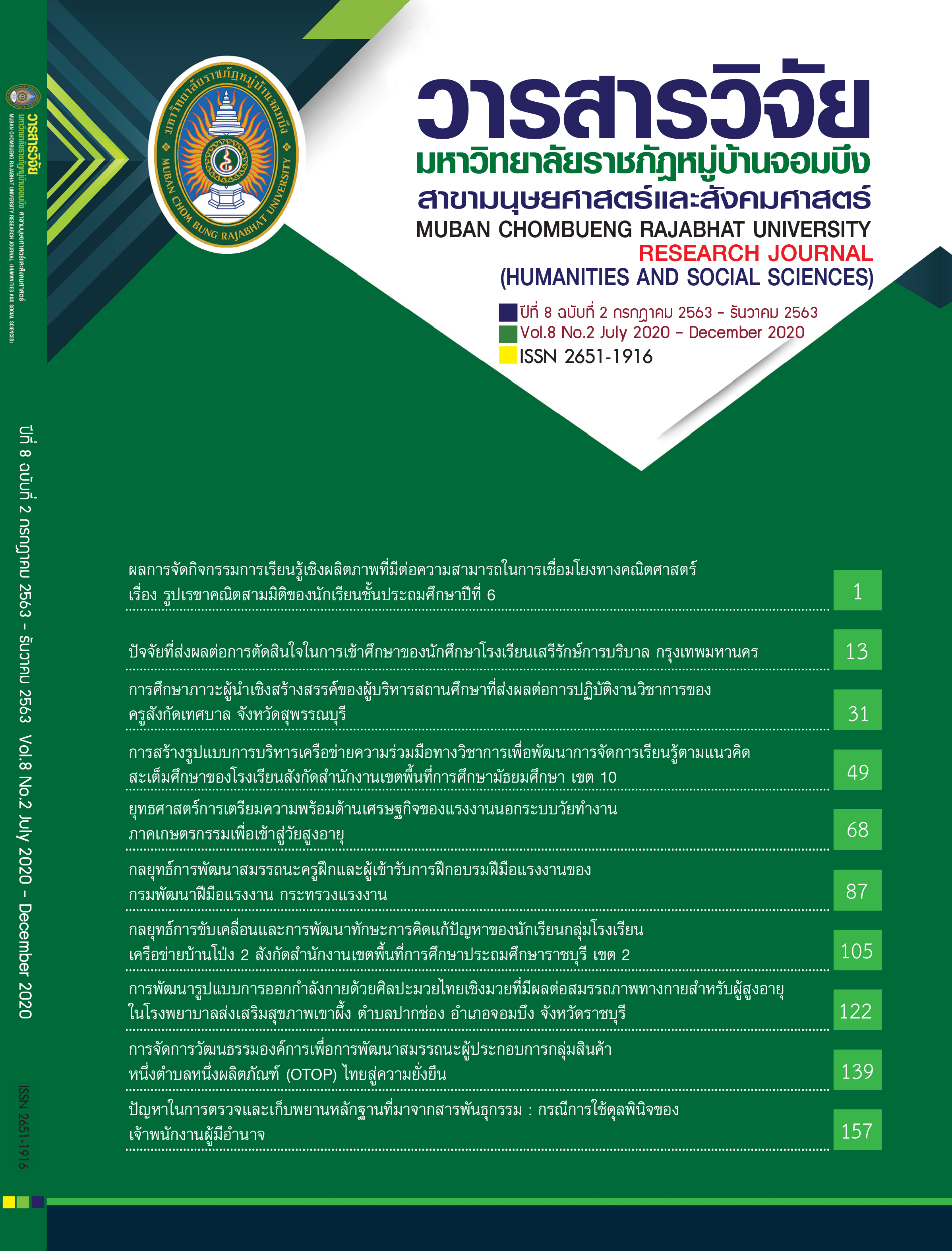กลยุทธ์การขับเคลื่อนและการพัฒนาทักษะการคิดแก้ปัญหาของนักเรียนกลุ่มโรงเรียนเครือข่าย บ้านโป่ง 2 สังกัดสำนักงานเขตพื้นที่การศึกษาประถมศึกษาราชบุรี เขต 2
คำสำคัญ:
กลยุทธ์การขับเคลื่อน, กลยุทธ์การพัฒนา, ทักษะการคิดแก้ปัญหาบทคัดย่อ
การวิจัยครั้งนี้มีวัตถุประสงค์เพื่อศึกษา 1) กลยุทธ์การขับเคลื่อนการพัฒนาทักษะการคิดแก้ปัญหาของนักเรียนกลุ่มโรงเรียนเครือข่ายบ้านโป่ง 2 2) กลยุทธ์การพัฒนาทักษะการคิดแก้ปัญหาของนักเรียนกลุ่มโรงเรียนเครือข่ายบ้านโป่ง 2 และ 3) ผลการพัฒนาทักษะการคิดแก้ปัญหาของนักเรียนกลุ่มโรงเรียนเครือข่ายบ้านโป่ง 2 กลุ่มตัวอย่าง คือ ครูกลุ่มโรงเรียนเครือข่ายบ้านโป่ง 2 จำนวน 5 คน และนักเรียนชั้นมัธยมศึกษาปีที่ 1-3 จำนวน 177 คน เครื่องมือที่ใช้ในการวิจัย ได้แก่ 1) คู่มือการใช้กลยุทธ์การขับเคลื่อนและการพัฒนาทักษะการคิดแก้ปัญหาของนักเรียน 2) แบบทดสอบวัดความรู้ความ เข้าใจของครูเกี่ยวกับการพัฒนาทักษะการคิดแก้ปัญหาของนักเรียน 3) แบบทดสอบวัดทักษะการคิดแก้ปัญหาของนักเรียนก่อนใช้และหลังใช้กลยุทธ์การพัฒนาทักษะการคิดแก้ปัญหาของนักเรียน และ 4) แบบสัมภาษณ์ การวิเคราะห์ข้อมูลโดยใช้สถิติ คือ ร้อยละของความก้าวหน้า ค่าเฉลี่ย และส่วนเบี่ยงเบนมาตรฐาน
ผลการวิจัย พบว่า 1) กลยุทธ์การขับเคลื่อนการพัฒนาทักษะการคิดแก้ปัญหาของนักเรียนกลุ่มโรงเรียนเครือข่ายบ้านโป่ง 2 สังกัดสำนักงานเขตพื้นที่การศึกษาประถมศึกษาราชบุรี เขต 2 มี 4 กลยุทธ์ ได้แก่ กลยุทธ์เครือข่าย กลยุทธ์การมีส่วนร่วม กลยุทธ์การเสริมพลังอำนาจ และกลยุทธ์การบูรณาการ 2) กลยุทธ์ที่ครูเครือข่ายใช้ในการพัฒนาทักษะการคิดแก้ปัญหาของนักเรียนคือ การสอนแบบสะเต็มศึกษาบูรณาการกระบวนการคิดแก้ปัญหาภายใต้กรอบการดำเนินการของคู่มือการพัฒนาทักษะการคิดแก้ปัญหาของนักเรียนกลุ่มโรงเรียนเครือข่ายบ้านโป่ง 2 สังกัดสำนักงานเขตพื้นที่การศึกษาประถมศึกษาราชบุรี เขต 2 3) ผลการพัฒนาทักษะการคิดแก้ปัญหาของนักเรียนกลุ่มโรงเรียนเครือข่ายบ้านโป่ง 2 สังกัดสำนักงานเขตพื้นที่การศึกษาประถมศึกษาราชบุรี เขต 2 พบว่า ก่อนใช้กลยุทธ์การพัฒนา ค่าเฉลี่ยเท่ากับ 12.02 และส่วนเบี่ยงเบนมาตรฐานเท่ากับ 2.15 หลังใช้กลยุทธ์การพัฒนา มีค่าเฉลี่ยเท่ากับ 24.64 และ ส่วนเบี่ยงเบนมาตรฐานเท่ากับ 2.23 และหลังใช้กลยุทธ์การพัฒนา นักเรียนมีทักษะการคิดแก้ปัญหาสูงขึ้นจากเดิมคิดจากร้อยละของความก้าวหน้าเพิ่มขึ้น 42.07
เอกสารอ้างอิง
วัชรา เล่าเรียนดี. (2556). ศาสตร์การนิเทศการสอน และการโค้ช การพัฒนาวิชาชีพ : ทฤษฎีกลยุทธ์สู่การปฏิบัติ. (พิมพ์ครั้งที่ 12). นครปฐม: โรงพิมพ์มหาวิทยาลัยศิลปากร วิทยาเขตพระราชวังสนามจันทร์ นครปฐม.
สถาบันส่งเสริมการสอนวิทยาศาสตร์และเทคโนโลยี. (2561). “สะเต็มศึกษา” [STEM Education].กรุงเทพฯ: สถาบันส่งเสริมการสอนวิทยาศาสตร์และเทคโนโลยี.
สุวิทย์ มูลคํา. (2551). กลยุทธ์การสอนคิดแก้ปัญหา.กรุงเทพฯ: ภาพพิมพ์.
สำนักงานเขตพื้นที่การศึกษาประถมศึกษาราชบุรีเขต 2. (2562). ข้อมูลจำนวนครูและนักเรียนอำเภอบ้านโป่ง จังหวัดราชบุรี. ราชบุรี
สํานักงานเลขาธิการสภาการศึกษา. (2560 ). แนวทางการจัดการเรียนรู้ ที่เน้นผู้เรียนเป็นสําคัญ การจัดการเรียนรู้ แบบกระบวนการแก้ปัญหา. กรุงเทพฯ: ชุมนุมสหกรณ์การเกษตรแห่ง ประเทศไทย.
อนันต์ ม่วงอุมิงค์. (2560). กลยุทธ์การขับเคลื่อนการพัฒนาคุณลักษณะอันพึงประสงค์ของนักเรียนมุสลิมโรงเรียนพัฒนศาสน์วิทยาท่าแร้ง จังหวัดเพชรบุรี. วิทยานิพนธ์ครุศาสตร มหาบัณฑิต, มหาวิทยาลัยราชภัฏเพชรบุรี.
Scott, C. (2012). An Investigation of Science, Technology, Engineering and Mathematics (STEM) Focused High School in the U.S. Journal of STEM Education, 13(5): 30–39.
Shields, C. (2006). Engineering our future New Jersey elementary school. Retrieved October 14, 2017, from http://www.ciese.org/papers/2006/ASEE_paper_G.doc.
ดาวน์โหลด
เผยแพร่แล้ว
รูปแบบการอ้างอิง
ฉบับ
ประเภทบทความ
สัญญาอนุญาต
วารสาร TCI อยู่ภายใต้การอนุญาต Creative Commons Attribution-NonCommercial-NoDerivatives 4.0 International (CC BY-NC-ND 4.0) เว้นแต่จะรุบุไว้เป็นอย่างอื่นโปรดอ่านหน้านโยบายของเราสำหรับข้อมูลเพิ่มเติมเกี่ยวกับการเช้าถึงแบบเปิด ลิขสิทธิ์ และการอนุญาต



